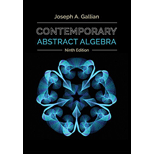
For
To find all positive integers less than given n and relative prime to n
Answer to Problem 1E
All positive integers that are relative primes to:
- 5 are 1, 2, 3 and 4 (less than 5)
- 8 are1, 3,5 and 7 (less than 8)
- 12 are 1, 5, 7 and 11 (less than 12)
- 20 are 1, 3, 7, 9, 11, 13, 17 and 19 (less than 20)
- 25 are 1, 2, 3, 4, 6, 7, 8, 9, 11, 12, 13, 14, 16, 17, 18, 19, 21, 22, 23 and 24 (less than 25)
Explanation of Solution
Given information:
Concept Used:
Two numbers are relatively prime if they have no factors in common other than 1, thus two relatively prime numbers have a greatest common factor, or GCF, of 1.
Calculation:
In order to determine all positive integers less than nand relative prime to respective n we have to find all the integers less than n that have no common factor with n other than 1
First, let’s find all positive integers less than given 5and relative prime to 5, since number 1, 2, 3 and 4 have no common factor with 5 other than 1, thus 1, 2, 3 and 4 are relative prime to 5
Now, let’s find all positive integers less than given 8and relative prime to 8, since number 1, 3,5 and 7 have no common factor with 8 other than 1, thus 1, 3, 5 and 7 are relative prime to 8
Similarly, we find all positive integers less than given 12and relative prime to 12, since number 1, 5, 7 and 11 have no common factor with 12 other than 1, thus 1, 5, 7 and 11 are relative prime to 12
Similarly, we find all positive integers less than given 20and relative prime to 20, since number 1, 3, 7, 9, 11, 13, 17 and 19 have no common factor with 20 other than 1, thus 1, 3, 7, 9, 11, 13, 17 and 19 are relative prime to 20
Similarly, all positive integers less than given 25and relative prime to 25 can be found as, since number 1, 2, 3, 4, 6, 7, 8, 9, 11, 12, 13, 14, 16, 17, 18, 19, 21, 22, 23 and 24 have no common factor with 25 other than 1, thus 1, 2, 3, 4, 6, 7, 8, 9, 11, 12, 13, 14, 16, 17, 18, 19, 21, 22, 23 and 24 are relative prime to 25
Hence, we get all positive integers that are relative primes to:
- 5 are 1, 2, 3 and 4 (less than 5)
- 8 are1, 3,5 and 7 (less than 8)
- 12 are 1, 5, 7 and 11 (less than 12)
- 20 are 1, 3, 7, 9, 11, 13, 17 and 19 (less than 20)
- 25 are 1, 2, 3, 4, 6, 7, 8, 9, 11, 12, 13, 14, 16, 17, 18, 19, 21, 22, 23 and 24 (less than 25)
Want to see more full solutions like this?
Chapter 0 Solutions
Contemporary Abstract Algebra
- Solve questions by Course Name (Ordinary Differential Equations II 2)arrow_forwardplease Solve questions by Course Name( Ordinary Differential Equations II 2)arrow_forwardInThe Northern Lights are bright flashes of colored light between 50 and 200 miles above Earth. Suppose a flash occurs 150 miles above Earth. What is the measure of arc BD, the portion of Earth from which the flash is visible? (Earth’s radius is approximately 4000 miles.)arrow_forward
- e). n! (n - 1)!arrow_forwardSuppose you flip a fair two-sided coin four times and record the result. a). List the sample space of this experiment. That is, list all possible outcomes that could occur when flipping a fair two-sided coin four total times. Assume the two sides of the coin are Heads (H) and Tails (T).arrow_forwarde). n! (n - 1)!arrow_forward
- Evaluate the following expression and show your work to support your calculations. a). 6! b). 4! 3!0! 7! c). 5!2! d). 5!2! e). n! (n - 1)!arrow_forwardAmy and Samiha have a hat that contains two playing cards, one ace and one king. They are playing a game where they randomly pick a card out of the hat four times, with replacement. Amy thinks that the probability of getting exactly two aces in four picks is equal to the probability of not getting exactly two aces in four picks. Samiha disagrees. She thinks that the probability of not getting exactly two aces is greater. The sample space of possible outcomes is listed below. A represents an ace, and K represents a king. Who is correct?arrow_forwardConsider the exponential function f(x) = 12x. Complete the sentences about the key features of the graph. The domain is all real numbers. The range is y> 0. The equation of the asymptote is y = 0 The y-intercept is 1arrow_forward

 Algebra: Structure And Method, Book 1AlgebraISBN:9780395977224Author:Richard G. Brown, Mary P. Dolciani, Robert H. Sorgenfrey, William L. ColePublisher:McDougal LittellAlgebra & Trigonometry with Analytic GeometryAlgebraISBN:9781133382119Author:SwokowskiPublisher:Cengage
Algebra: Structure And Method, Book 1AlgebraISBN:9780395977224Author:Richard G. Brown, Mary P. Dolciani, Robert H. Sorgenfrey, William L. ColePublisher:McDougal LittellAlgebra & Trigonometry with Analytic GeometryAlgebraISBN:9781133382119Author:SwokowskiPublisher:Cengage


